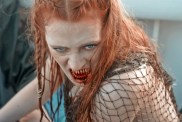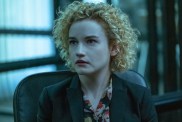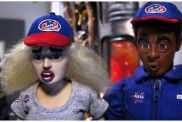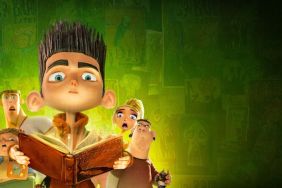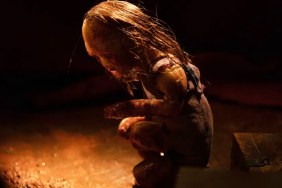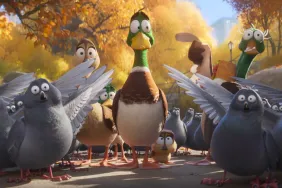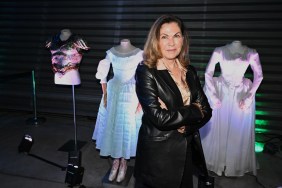Georgina walked us through the process of turning those designs into completed puppets and explained how all the main human characters use the face replacement technique, which is the purview of Brian McLean, director of “Rapid Prototype” comes in, something we’ll explain a bit later.
She explained how the zombie and ghost characters’ faces are done mechanically since it allows them animators to use “squash and stretch” to make them more expressive and creepier. This means that those puppets have tiny metal skulls with moving jaws and eye sockets, covered with silicon flesh, all which can be configured with tiny Allen wrenches in whichever way the animator needs to move them. We were told that the characters’ eyes are usually moved around using a razor-edged Xacto blade, which is quite jarring to watch.
The use of silicon flesh on the puppets has also created lots of happy accidents, because for one thing, it absorbs the paint in a way that makes the skin somewhat translucent so that it refracts light allowing the cinematographer make the puppets look even more lifelike.

There are limitations with hand-made puppets, because continuity is so crucial that everything needs to be mapped out so that the hair on each puppet of a character is identical. Each of the 175 spikes in Norman’s hair – they used colored goat hair to create it – had to be consistent between the different puppets, so they created special guides and maps so that everyone working on the wigs would make them identical. They also made special stunt wigs for certain scenes that would allow hair to be moved by the animators if they wanted to show wind or motion. We also got to see how Courtney’s distinctive blonde ponytail was created to allow for natural movement when she moves her head back and forth, something done by hiding a wire inside that the animators could easily move.

Face Replacement Animation and 3D Printers

For ParaNorman, they need to have virtually identical face pieces with varying expressions and they’ve figured out a genius way of producing these using 3D color printers that can literally print out exact duplicates of 3D graphics created in the computer, modifying each one slightly so that they can be combined to create animated facial expressions.
This all comes together in LAIKA’s “Rapid Prototyping Department,” run by Brian McLean (above left) and made up for 40 different artists and computer specialists, using methods normally used in other industries to make the art of stop-motion animation simpler. First, they take the original character head sculpts and scan them into the computer then they use programs to animate the facial expressions in the computer and determine which separate sculpts they need to create the facial expressions. Once that’s done, they use a high-tech 3D printer to print out the required pieces. Each face is made up of two parts, the forehead and eyebrows and the mouth, while the eyes are done mechanically, a process which allows them to have literally thousands of different facial expressions for the human characters. The big difference now is that they don’t have to hand-paint each of these faces, which not only takes time but also means things like freckles have to be kept fairly simple for continuity. Using this process, they ended up with nearly 8,000 separate facial pieces for Norman alone, which could be combined for something like 300,000 facial expressions.
The 3D printers are pretty cool as they’re essentially like laser jet printers except instead of printing on paper line by line, it’s actually sculpting using this powdery silicon substance that it transforms into the solid silicon pieces that become the puppet’s faces. Unlike the painted plastic faces they used before, these are able to seamlessly blend in with the rest of the silicon skin on the puppets. It took a lot of trial and error to get the coloring exactly right since the printers weren’t able to accurately recreate the colors in the computer, having problems with certain shades and colors, so they did all sorts of tests to figure out how to offset the color in the computers to be printed out as they wanted.

This then brings us to something called “The Face Library.” That’s right. There is a room at LAIKA where you walk in and it’s lined with shelves piled high with plastic containers that contain every imaginable face needed for all the different characters, each numbered and labelled and easy to find whenever the animator needs them for a scene. It’s actually kind of a mind-blowing process to think about how much preparation has to be done before the animator even get to the stage to start animating a sequence.
We also saw a “plastic printer” at work, which literally creates solid 3-dimensional objects out of plastic that can be used for other objects and parts that needed to be created for the production. (Production designer Nelson Lowery would take us to the “props department” later where we’d see some of the objects created and how they used the printers to make some of the pieces.)
The Sets and Rigging
Now that they have built the puppets and figured out a way to animate them, they needed to create environments in which they can exist as well as ways for them to interact with those environments.
The latter part is where the rigging department comes in, as they’re responsible for creating ways to let the animators make the figures move naturally, whether jumping or simply moving so that arms and legs can be moved while keeping the puppet bodies in a stationary position. The film’s Rigger Supervisor Oliver Jones gave us a really quick overview of how they use specially-constructed rigs to keep the puppets stationary while animating them. He also showed us how rigging is used for special scenes like when the zombies burst from out of their graves and they needed to have bits of ground and rock flying through the air, and they put each separate clump of dirt on a wire on set.

As far as the sets themselves, the directors and production designer Nelson Lowry took a trip out to the East Coast and visited his hometown of Weymouth, Massachusetts to check out small town New England architecture as reference for the buildings and finding the perfect house for Norman.
You’d expect that working with puppets, the sets would be fairly small but in fact, there were many that were quite enormous since the buildings had to be in proper scale with the puppets we saw earlier. One of the more impressive sets was the exterior of Norman’s school, which was absolutely enormous and it actually looked a lot like my own elementary school in Framingham, Massachusetts. This was an extremely elaborate stage with grass and concrete paths leading up to the door, and it’s a stage that had been used for a couple more scenes during daytime and night. The nighttime scene is for when people show up for a school play being put on by Norman and other kids, which acts as a story within the story for the characters to give a recap of the story so far in an interesting way, and we got to see the stage with all the puppets dressed up for the play. The attention to detail in building this set was just as impressive as some of the larger sets.
We saw the outside of Norman’s uncle Mr. Penderghast’s house, which was actually fairly small on a set that included the woods and a stone path leading up through it. This was built for one establishing shot of Norman riding his bicycle up to the house, and this was being shot using a tiny digital camera mounted on a giant crane. The animator on-set walked us through how they were rehearsing this scene to perfect it before shooting.
After that, we went around to a couple different stages to talk to the animators as they took breaks from their work, and we also talked to cinematographer Tristan Oliver who was busy doing some elaborate lighting for a sunset scene in the forest. He explained his role in working with the animators and setting up the shots, and surprisingly, all of the camera movements are preprogrammed and computerized. Because stop-motion animation is such a delicate process since you have to move every element so minutely and all the animator has to do is make each movement, then push a button and the camera automatically take a snapshot of the left eye and then the right eye and then will move in the way the cinematographer has predetermined. They end up shooting roughly 80 frames per day but they still have to do blocking and “rehearsals” so an animator might spend ten days shooting a scene just to test out of it works, then they’ll show that footage to the directors, they’ll make changes and then they’ll do it again for real.

Jason showed us a bit more how he and the other animators work with the preprogrammed computerized cameras and how he used himself for reference while doing the animation. Having come from a show where he mechanically animated the faces, it took some time for him to adjust to the face replacement technique. He told us he has been enjoying doing some of the more comedic bits although having worked for months on some sequences, he admitted to have sometimes hit a point burnout where he was ready to “grab a puppet and burn it.” Yikes.
Now, if you can imagine all the above seen over the course of a short couple hours, you can only imagine what an amazing immersive experience this was to see how the day-to-day workings of LAIKA, and how they’ve managed to take a fairly simple idea from Chris Butler’s head and transform it into a full-on stop-motion animated movie.
To see how it all turns out, ParaNorman opens on August 17th.
